How digital, AI and ESEF are reshaping reporting
- AI loves ESEF reporting
- AI needs higher quality reports
- ESEF's secret superpower
- ESEF reports need to improve
- ESEF reports are being inspected
- Limitations of PDF data
- Why regulators support a digital-first process
- Painful, expensive processes are being transformed
- 85% of stakeholders choose ESEF over PDF
- Making digitisation simple
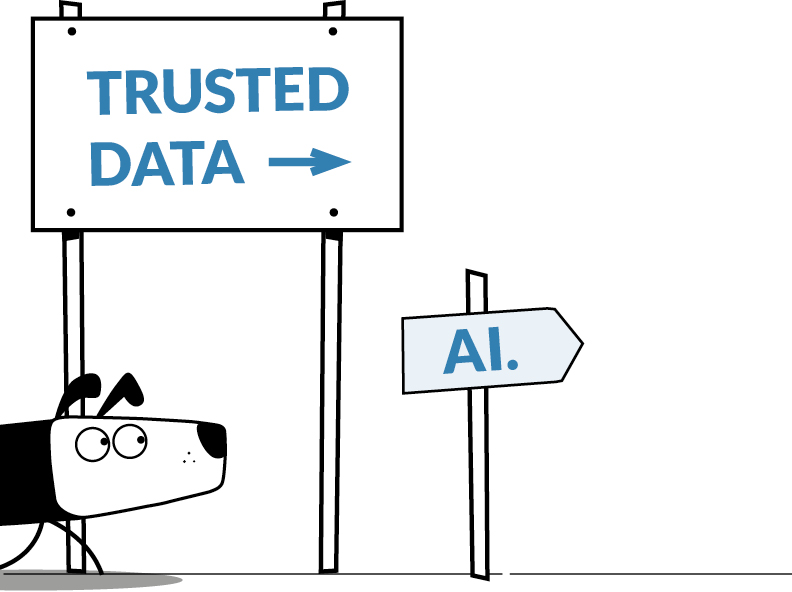
1. AI loves ESEF reporting
AI is revolutionising analysis of reporting data. A 2024 survey by the UK's Financial Conduct Authority (FCA) found that 75% of financial services firms are already using AI for analysis, with another 10% planning to adopt it in the next three years. The quality of data that AI accesses is critical for trust.
While PDFs have been a mainstay of reporting and communications for over 30 years, the impact of Al is challenging this. PDF reports are too hard for Al to read and analyse reliably.
Al needs HTML. Step forward ESEF.
ESEF reports are AI's best friend. They speak the same language - HTML. On top of this, if ESEF reports are published online they are supercharged with data tagging (iXBRL), enabling more reliable, trusted AI analysis.
So far so good. But there's one small wrinkle.
Most ESEF reports are converted from PDF to HTML, which inherits all the limitations of PDF. This means that most companies' ESEF reports are completely unusable.
To keep up with AI, reporting needs to improve.
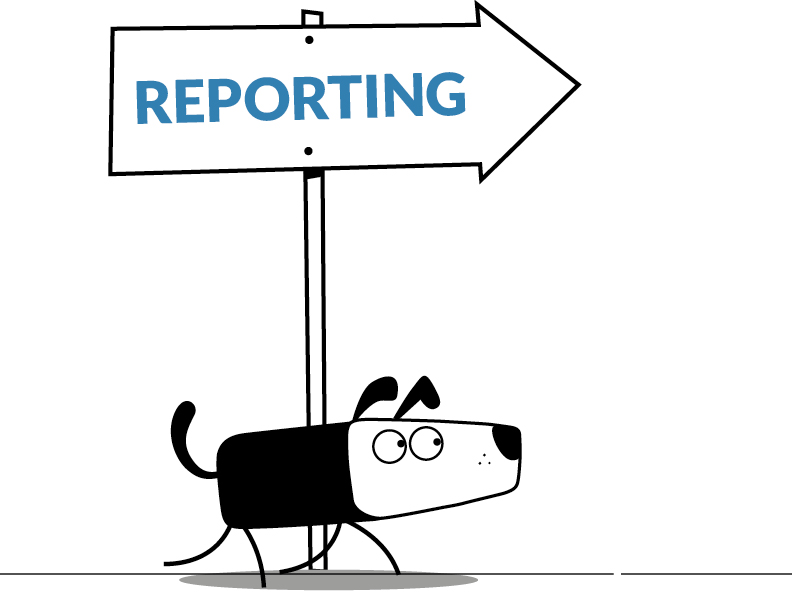
2. AI needs higher quality reports
AI is only as good as the content and data it can access.
Put trash in, get trash out.
Creating an ESEF report by converting from PDF to HTML delivers messy, bloated and unstructured code. This reduces the performance of AI analysis, which reduces the usefulness and trust in your reporting.
It sounds like a complex problem, but it is surprisingly easily solved.
The ESEF report just needs to be created in digital-first design software. Also known as 'native HTML' – ie not converted from a PDF.
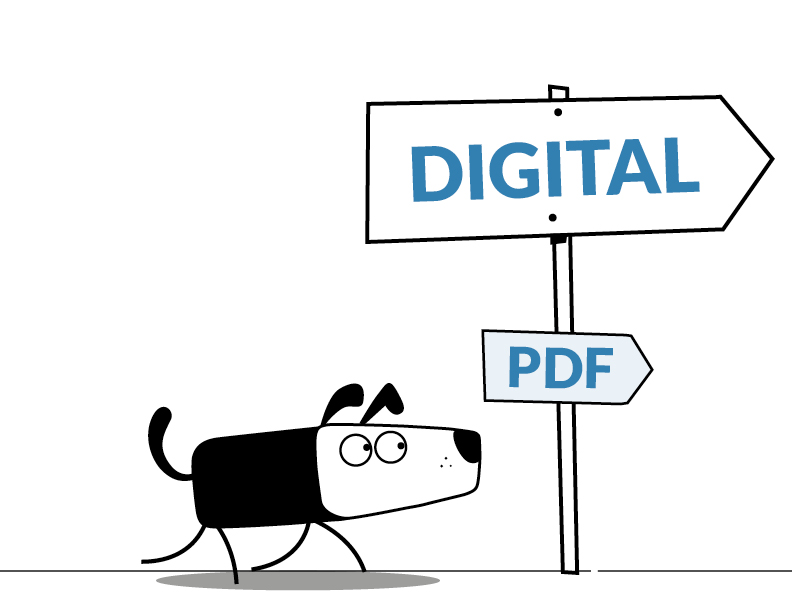
3. ESEF's secret superpower
The ESEF format isn't only good for AI. It has another, less well known, superpower. When I first discovered this, it stopped me in my tracks.
ESEF has the same communications capabilities as any website.
If we create the ESEF report properly, it becomes a web format for everyone to access – and crucially, gives AI the data it needs, more efficiently and reliably.
This changes everything in reporting.
a.The best ESEF reports can be interactive, searchable, accessibility compliant and Google friendly.
b. When we create it properly, the ESEF report can be viewed by anyone, on all devices, without any special software. Easy-to-use mobile friendly reporting. At last!
c. Advanced ESEF reporting software now enables companies to move their reporting easily to the AI-enabled, digital-first age. While also keeping the PDF and print version as well.
d.Digital-first online ESEF reports offer vital user analytics - revealing valuable insights into reporting stakeholders and their preferences, driving year-on-year improvements.
4. ESEF reports need to improve
Digitisation demands constant improvement, and ESEF is no different.
Regulators have identified problems with companies’ mandatory ESEF reports, and have said that the reporting quality is not at the levels they expect:
“We expect issuers to devote the same level of care and attention to their digital [ESEF] report as they do to their reports in PDF or print.”
Financial Conduct Authority (FCA)
“Preparers spend significant resource to ensure that the printed / PDF annual report is of high quality, and this same level of attention is not always flowing through to the digital [ESEF] annual report.”
Financial Reporting Council (FRC)
The poor quality, unusable ESEF reports you see today are starting to be transformed by a digital-first approach. We hope that increased awareness and AI's demand for higher quality data will help to drive that continued improvement.
5. ESEF reports are being inspected
Creating a high quality digital report isn't just about AI readability, it's about compliance too.
In April 2025, the FRC announced that digital ESEF reports are being inspected and they intend to write to companies about problems found. Additionally, from 2026, ESEF reports will fall under Provision 29 rules, requiring board declaration on effective reporting and compliance controls.
“As the official version, the digital [ESEF] report should be subject to appropriate review and governance processes. Where issues and errors in the tagging are identified the FRC may write directly to those preparers.”
Financial Reporting Council (FRC)
As specialists in digital reporting, iXBRL audit and compliance, we are helping our clients to adhere to the regulatory standards and guidelines, and ensure effective ESEF compliance controls processes are in place.
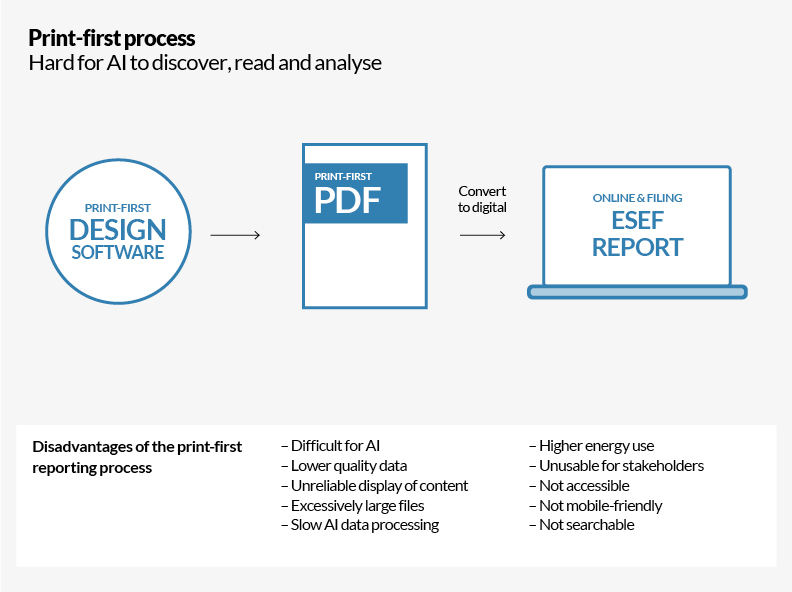
6. Limitations of PDF data
As a legacy of print-first design software, many companies still create their mandatory ESEF report by converting a print format (PDF) to digital (HTML) – known as a ‘bolt-on’ process.
Print design software wasn’t built for this purpose and has many limitations.
Independent experts in data quality have advised:
“PDF to HTML conversion tools translate PDFs to HTML almost pixel by pixel, resulting in messy and inefficient HTML code behind the scenes. Slow load times and large file sizes are often caused by inefficient HTML.”
Financial Reporting Council (FRC)
“Companies should consider creating the report HTML natively, rather than converting a PDF to HTML.”
XBRL International
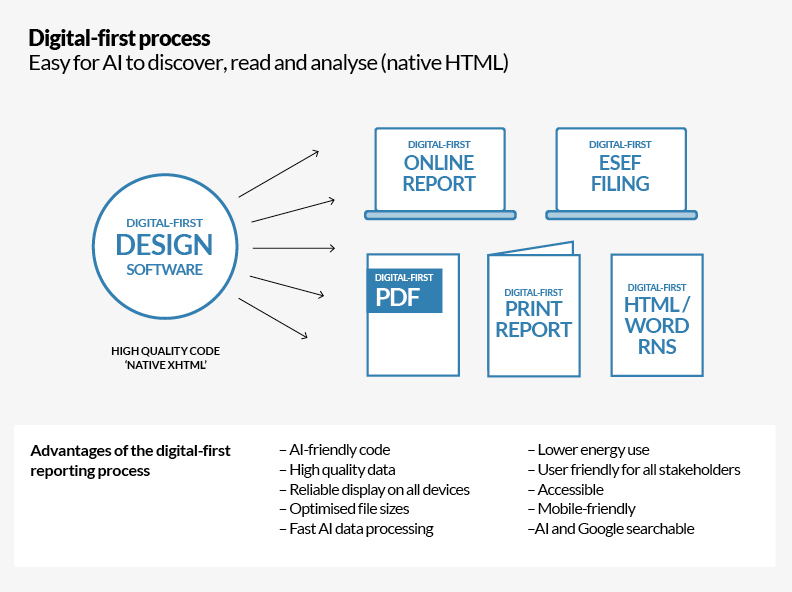
7. Why regulators support a digital-first process
Regulators in the UK and EU have highlighted how a digital-first processcan help companies to improve their reporting – including data quality, efficiency, controls, accessibility and usability.
So, what does a ‘digital-first process’ mean?
Digital first simply means that all report versions are created using digital design software (from ‘native HTML’ code), not print design software.
“It is advisable to start with an HTML-based document. This offers many procedural advantages over a PDF-converted document.”
AFM - Netherlands regulator
This digital-first process uses a single-source of content, which ensures consistency and high quality data across all report versions - PDF, online, ESEF filing, print.
“Companies may want to consider how to get the best of both digital and PDF/print formats. Truly ‘web-based’ structured [ESEF] reports can only be created using a new generation of ‘native XHTML’ reporting tools.”
Financial Reporting Council (FRC)
Best practice digital processes are outlined by the FRC:
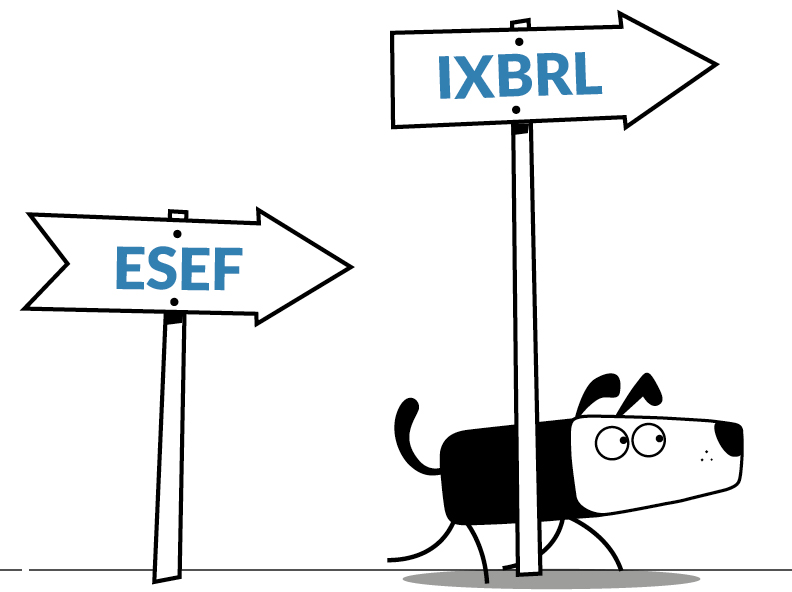
8. Painful, expensive processes are being transformed
Advances in software are driving efficiencies across the whole reporting process.
In digital-first reporting software, when the report is signed off, all the formats you need can be exported in a click from a single source of content – PDF, online, announcement, print and ESEF filing.
Browser-based editing means you don't need any special software. Innovative functions include instant previews of all formats, sync with data sources, linking data/content between sections and versions, and automation of tasks like table of contents and page cross-references.
Another challenge of print-first software is making reports accessible. A print-based PDF can't ever be truly accessible and mobile responsive. But digital-first reporting enables us to solve this simply, because HTML is easy to make fully accessible (WCAG).
Finally, an often overlooked benefit is that in a digital-first and AI world, a report's page count is not as important as it once was. In digital reporting a Google or AI search takes users straight to the content they need - so a report's length matters less.
9. 85% of stakeholders choose ESEF over PDF
Limited by print-first processes, the majority of ESEF reports today are unusable for most stakeholders. PDF has remained a better format for users than ESEF.
But with the transformation of ESEF, everything changes.
User data from the new generation of online ESEF reports has turned all our previous assumptions upside down.
Since March 2024, analytics from more than 30,000 visits to online ESEF reports show that 85% of stakeholders choose a digital-first ESEF report over a PDF. (This is data on actual user behaviour, not a survey.)
These online ESEF reports are also attracting many more visitors. On average digital-first ESEF reports are visited 12x more than older print-first PDF reporting.
But this is not a fight between digital vs PDF formats. The data also shows that PDF still remains very popular as well. Another benefit of creating all formats digitally.
What do digital-first ESEF reports look like?
Just like a website. With all the same benefits. And the added boost of XBRL tagging which improves AI analysis.
All these report versions (PDF, print, online, filings) were created entirely in digital-first software:
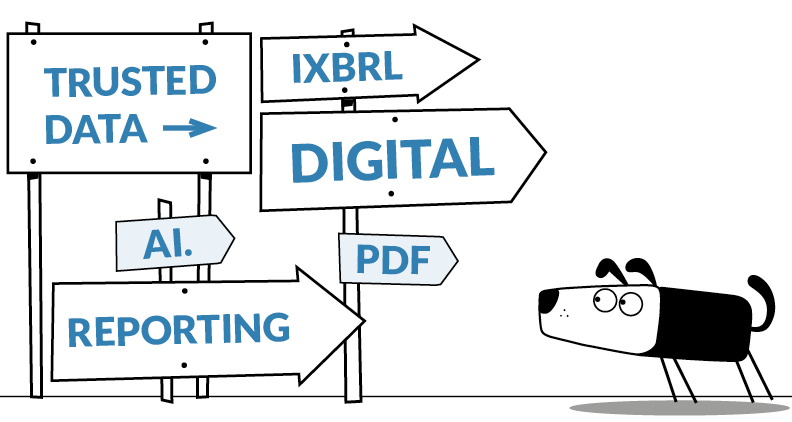
10. Making digitisation simple
We are now in a world of HTML, iXBRL, ESEF, CSRD, ISSB, WCAG and AI. Reporting requires more technical expertise than ever, and choosing suitable software is crucial.
At Friend Studio, we offer a range of options to best meet our clients' needs. This ensures reporting becomes more efficient to create and remains easy for stakeholders to use.
Alongside our expertise in InDesign, CtrlPrint and Workiva, we now offer more advanced AI-friendly reporting software Reportl – purpose-built to enable digitisation and meet fast-changing AI demands.
Reportl introduces many process efficiencies and controls improvements. And it brings countless communications benefits including beautifully designed, accessible reporting in every format you need – all published in a click from a single source of content.
This is helping us to make digitisation simple for our clients.
For more information visit reportl.com and get in touch with Friend hello@friendstudio.com